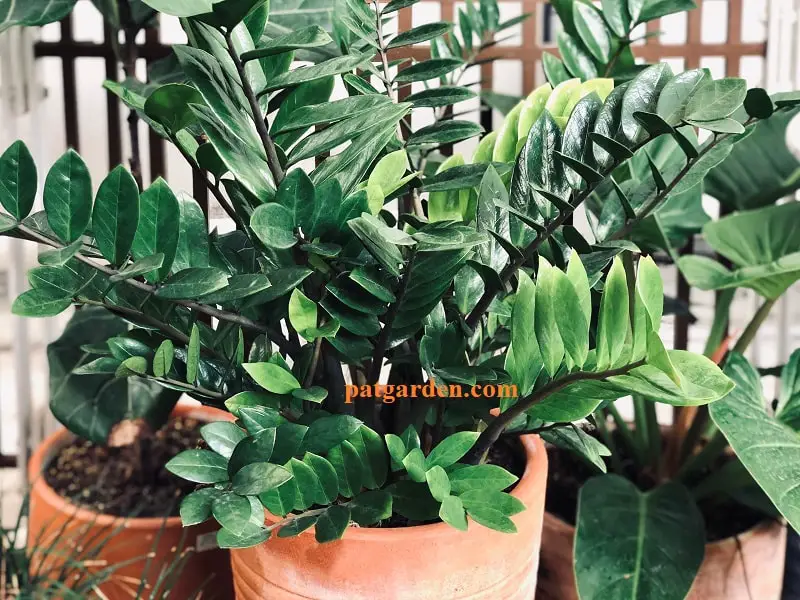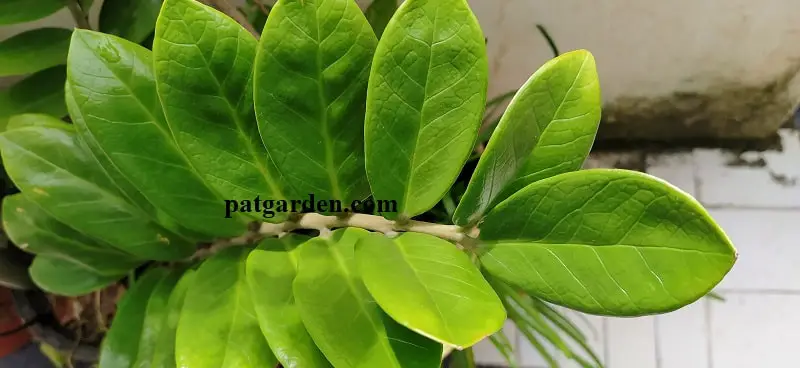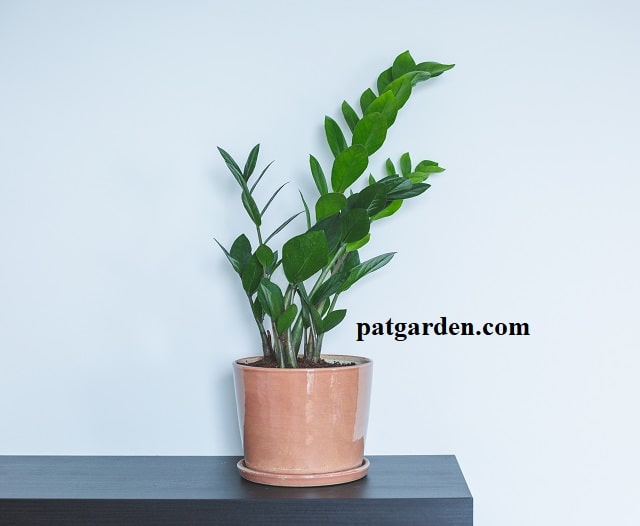The ZZ plant (Zamioculcas zamiifolia) is one of the most beautiful and unique houseplants on the market. The attractive appearance will help improve your living room or office space.
One of the most incredible things is that the indoor plant is difficult to kill. It can be neglected for months and withstand low light exposure. But the houseplant will still look amazing.
Yellowing of leaves is one of the most common problems affecting the ZZ plant. This article provides insights into the causes and ways on how to fix yellow leaves on the ZZ plant.
Why does my ZZ plant have yellow leaves? The most common causes are overwatering, under-watering, over-feeding, extreme temperatures, and light. Keep reading for more insights.
It would be best to investigate the cause and take the right course of action. Identifying the potential reasons will help you understand what is making your houseplant is unhappy.
You May Also Like: Why Are My ZZ Plant Leaves Curling?

Causes of ZZ Plant Yellow Leaves and What to Do
Overwatering
Most indoor plants are highly susceptible to root-rot. The disease usually kills the plant if not fix at the right time. The condition occurs due to exposing the root system to soggy soil for an extended period.
So, can overwatering make the ZZ plant have yellow leaves? Absolutely. Root rot and fungal growth destroy the root system which inhibits the absorption of nutrients. Hence, the reason behind the yellowing of leaves.
Overwatering makes the houseplant soil soggy. The wet environment encourages rapid fungal growth and the spread of root rot disease. These issues stop the plant from absorbing vital nutrients and minerals from the soil.
Solutions: Check the moisture content of the soil and color of the roots. Brown patch is an indicator of root rot and white display a healthy root system. Cut the affected parts of the root and repot the plant. Remember to stick to the watering schedule of the ZZ plant.
Under-watering
ZZ plant is a drought-resistant houseplant. It can go for months without water and there is a high chance of the grower to forget the watering routine.
So, can under-watering make ZZ plants develop yellow leaves? Yes. The soil will become dry which might distress the root system. Change in leaves color and drooping is a sign of under-watering.
The good news is that adjusting the watering schedule will help to rejuvenate your indoor plant. Otherwise, the chances of the ZZ plant surviving in dry soil will be limited if the condition persists.
How much water does a ZZ plant need? The houseplant needs to be watered once a week in summer and twice or thrice a month during winter. But always have the habit of checking the soil first.
Solutions: Begin watering the plant slowly and try to avoid overwatering. Create some drainage holes on the container to expel excess water. Mix soluble fertilizer and water to boost the health and nutrition of your plant.

Excess Light Exposure
This is yet another possible reason for ZZ plants developing yellow leaves. The plant thrives in different light range. But exposing the indoor plant to bright direct light could cause damage.
The good news is that the ZZ plant is tolerant of low light and bright indirect sunlight. The condition helps to grow an attractive and healthy houseplant.
So, how much light does the ZZ plant need? The plant should not be exposed to direct light for more than four hours per day. The excess light will make the plant develop yellow leaves and later start developing brown tips due to scorching from the sun.
Solutions: Place the plant in a location that receives bright indirect light. The filtered light will help to prevent scorching and yellowing of leaves. Remember light is essential for enhancing photosynthesis in all green plants.
You May Also Enjoy: Pothos vs Philodendron
Improper Fertilization
ZZ plants can thrive in soil with imperfect growing conditions. But both excess and insufficient nutrients in the soil will make the plant leaves to turn yellow.
Balancing the nutrients in the soil and meeting all the nutrients required for ZZ plants will help to restore their attractive leaves’ color.
Solutions: Get soluble fertilizer rich in phosphorus and nitrogen. Apply the fertilizer to the plant monthly. Remember to follow the instructions on the fertilizer package to avoid nutrients imbalances.
Extreme Temperatures
ZZ plants are hardy plants. These houseplants can tolerate extreme temperatures in winter and summer. But too much exposure to the extreme temperature could result in the yellowing of leaves.
The indoor plant can tolerate a temperature range of about 50oF to 90oF (10-32oC). Any temperature outside the range could be the possible reason for yellow leaves on your plant.
Solution: Ensure the indoor space has a comfortable room temperature during the day and do not allow the temperature to go below 50oF at night.
Pest Infestations
ZZ plants are highly susceptible to insect infestations. Some of these insects usually suck sap from the plant that drains out the nutrients and moisture.
The good news is that the issue can be manifested by the yellowing of leaves and fronds. The most common insects invading ZZ plants are spider mites and mealybugs.
Sometimes the piercing of the plant leaves leads to the transmission of infection. The disease makes the indoor plant weak and ends up dying.
Solution: Purchase an insecticide meant for indoor plants and spray your plant. The chemical ingredients will suffocate and kill the insects. You can also use a cotton swab soaked in alcohol and rub it on the plant leaves to inhibit insect infestations.
What to Do when ZZ Plant Leaves Turn Yellow?
Here are steps to consider when treating ZZ plants with yellow leaves:
Repotting the Plant
The step is crucial when the yellow leaves are caused by overwatering. Repotting the ZZ plant will help to rejuvenate and avoid further damages.
Remove the Old Soil
Infected soil cause fungal disease in the root system. The condition stops the plant from absorbing essential nutrients that foster healthy growth. Removing the old soil will help to prevent the spread of fungal infection around the roots.
Examine the Root System
Shake and brush away the soil around the roots. Examine the color of the roots and try to prune roots that have brown patches. Sterilized the clipped regions and trash the prune roots.
Examine the Leaves and Stems
Prune yellow leaves and stems. Remember to sterilize the shears before using them to avoid the spread of infection. Cut the yellow foliage and stems from the point it emerges from the tuber.
Drench the Tuber in thiophanate Solution
Dealing with the ZZ plant with root rot is a daunting experience. The best solution is drenching the tuber of the plant is a solution of thiophanate. Always follow the instructions listed on the package before using it.
Use a New Container
Many growers make a lot of mistakes when repotting and treating a ZZ plant with yellow leaves. The majority usually maintain the old container. It would be best to use a brand new pot when repotting the plant.
Use Fresh Mix
Get a good mixture for houseplant potting. Ensure the potting mix has good drainage to prevent waterlogging in the container. Put the ZZ plant in the pot and backfill around the tuber.
Place the Plant in a Good Location
Recovering plants do experience drooping leaves. But this usually lasts for a couple of days and the plant regains its vibrant colors. Place the ZZ plant in an area that receives indirect light and other conditions that meet the ultimate requirements.
Outdoor Vacation
Taking the houseplant outside during spring and winter is recommended. The vacation allows the plant to experience natural freshness. Remember not to expose the houseplant to bright and direct sunlight to avoid scorching of leaves.
You May Also Like: Why Are My ZZ Plant Stalks Falling Over?
In Conclusion

The ZZ plant thrives in a location that receives plenty of bright indirect light, optimal soil moisture, and a temperature range of 70oF to 90oF. These are conditions that foster a healthy and happy houseplant.
Yellowing of the ZZ plant leaves is a result of overwatering, under-watering, excessive feeding, diseases, and pests. The good news is that most of these issues can easily be fixed to prevent killing your plant in the long run.
Take time to read through our recommendations and try to adjust to each condition. Implementation of these guidelines will help you grow the ZZ plant like a professional.
